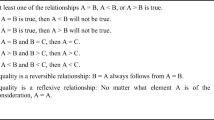Abstract
In this paper, we analyse the processes through which students come to negotiate mathematical meanings for reflective symmetry. We describe a microworld, Turtle Mirrors, designed to provide tools to help students focus simultaneously on actions, visual relationships and symbolic representations. Through a detailed case study of one student‘s thinking-in-change, we examine how the interactions with her partner and with the machine support a fusion of spontaneous and scientific concepts. Other examples of students‘ work further illustrate how the microworld tools offer a means to supplement local understandings of symmetry with those with more explicit, mathematical formulations.
Similar content being viewed by others
Explore related subjects
Discover the latest articles, news and stories from top researchers in related subjects.REFERENCES
diSessa, A.: 1985, ‘A principled design for an integrated computational environment’, Human Computer Interaction1, 1–47.
Edwards, L. D.: 1991, ‘Children’s learning in computer microworld for transformation geometry’, Journal of Computers in Mathematics Education22(2), 122–137.
Edwards, L. D.: 1992, ‘A comparison of children’s learning in two interactive computer environments’, Journal of Mathematical Behaviour11, 73–81.
Edwards, L. D. and Zazkis, R.: 1993, ‘Transformation geometry: Naive ideas and formal embodiments’, Journal for Computers in Mathematics and Science Teaching12(2), 121–145.
Grenier, D.: 1987, ‘The pupils’ conceptions on axial symmetry: An individual activity’, in R. Herschkowitz and S. Vinner (eds.), Geometry working group report from the 10th conference and some subsequent reactions, Report presented by the 11th International Conference for the Psychology of Mathematics Education, Montréal, Canada, pp. 14–27.
Harel, I. and Papert, S. (eds.): 1991, Constructivism, Norwood, New Jersey: Ablex Publishing Corporation.
Herschkowitz, R.: 1990, ‘Psychological aspects of learning geometry’, in P. Nesher and J. Kilpatrick (eds.), Mathematics and Cognition, A Research Synthesis by the International Group for the Psychology of Mathematics Education, ICMI Study Series (31–52), Cambridge University Press.
Hoyles, C. and Healy, L.: 1997, ‘Un micro-monde pour la symetrie axiale: une base de co-construction deconcepts mathématiques?’, Sciences et Techniques Educatives4(1), 67–97.
Hoyles, C., Sutherland, R. and Healy, L.: 1991, ‘Children talking in computer environments: New insights on the role of discussion in mathematics learning’, in K. Durkin and B. Shire (eds.), Language in Mathematical Education: Research and Practice, Milton Keynes: Open University Press, pp. 162–175.
Hoyles, C. and Sutherland, R.: 1990, ‘Pupil collaboration and teacher intervention in the logo environment’, Journal für Mathematik–Didaktik90(4), 323–343.
Hoyles, C. and Noss, R. (eds.): 1992, Learning Mathematics and Logo, Cambridge, Massachusetts: MIT Press.
Küchemann, D. E.: 1981, ‘Reflections and rotations’, in K. M. Hart (ed.), Children’s Understanding of Mathematics11–16, London: John Murray, pp. 137–157.
Leron, U. and Zazkis, R.: 1992, ‘Of geometry, turtles and groups’, in C. Hoyles and R. Noss (eds.), Learning Mathematics and Logo, Cambridge, Massachusetts: MIT Press, pp. 319–353.
Malkevitch, J.: 1995, ‘Geometry: Yesterday, today and tomorrow’, in Malkevitch, J. (ed.), Geometry’s Future, Arlington, Massachusetts: COMAP Inc, pp. 1–13.
Noss, R. and Hoyles, C.: 1992, ‘Looking back and looking forward’, in C. Hoyles and R. Noss (eds.), Learning Mathematics and Logo, Cambridge, Massachusetts: MIT Press, pp. 431–468.
Noss, R. and Hoyles, C.: 1996, Windows on Mathematical Meanings: Learning Cultures and Computers, Mathematics Education Library, Dordrecht: Kluwer.
Papert, S.: 1980, Mindstorms. Children, Computers, and Powerful Ideas, Brighton: Harvester.
Salomon, G., Perkins D. and Globerson T.: 1991, ‘Partners in cognition: Extending human intelligence with intelligent technologies’, Educational ResearcherApril, 2–9.
Schoenfeld, A. H., Smith, J. P. and Arcavi, A.: 1993, ‘Learning: The microgenetic analysis of one student’s evolving understanding of a complex subject matter domain’, in R. Glaser (ed.), Advances in Instructional PsychologyVol. 4, Lawrence Erlbaum Associates, pp. 55–177.
Smith, J. P, diSessa, A. and Roschelle, J.: 1993, ‘Misconceptions reconceived: A constructivist analysis of knowledge in transition’, Journal of the Learning Sciences3(2), 115–163.
Thompson, P.: 1987, ‘Mathematical microworlds and intelligent computer-assisted instruction’, in G. Kearsley (ed.), Artificial Intelligence and Instruction: Application and Methods, Reading MA: Addison-Welsey.
Vergnaud, G.: 1982, ‘Cognitive and development psychology research on mathematics education: Some theoretical and methodological issues’, For the Learning of Mathematics 3(2), 31–41.
Author information
Authors and Affiliations
Rights and permissions
About this article
Cite this article
Hoyles, C., Healy, L. Unfolding Meanings for Reflective Symmetry. International Journal of Computers for Mathematical Learning 2, 27–59 (1997). https://doi.org/10.1023/A:1009721414546
Issue Date:
DOI: https://doi.org/10.1023/A:1009721414546




